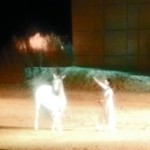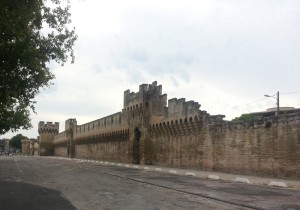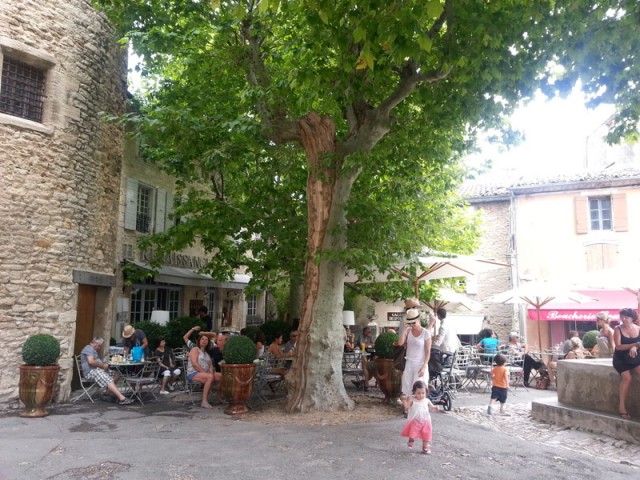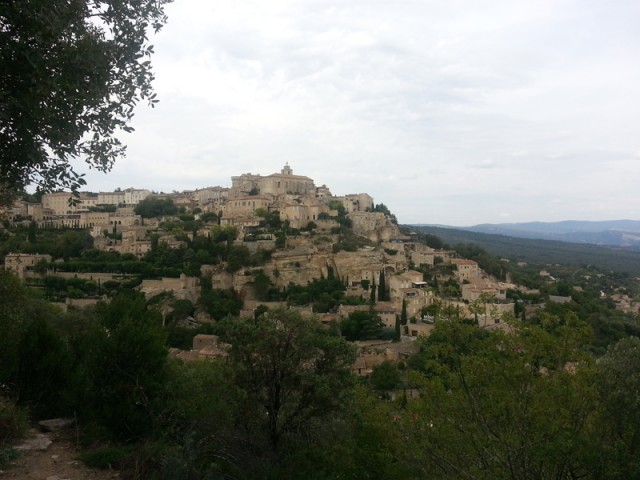 Twice in the past few years Vicki and I have been booked to travel to France to see Frédéric Pignon in action with horses. On both occasions we were scheduled to fence-sit during a liberty training clinic and we had to cancel each, the first time because Anaïs came down with colic and the second time because the Ice Queen threw us out of her livery yard (along with all of the other remaining paying customers) and we were hard put to find alternative accommodation. Third time lucky they say, and the saying was proved right when we had the opportunity to travel to the Provence in France to see Frédéric Pignon in action in the new Eqi Cheval Libre show which he and his wife Magalí Delgado, have produced. And thanks to a new-found friend and a thunderstorm, I also had a chance to chat to him at the end of it all.
Twice in the past few years Vicki and I have been booked to travel to France to see Frédéric Pignon in action with horses. On both occasions we were scheduled to fence-sit during a liberty training clinic and we had to cancel each, the first time because Anaïs came down with colic and the second time because the Ice Queen threw us out of her livery yard (along with all of the other remaining paying customers) and we were hard put to find alternative accommodation. Third time lucky they say, and the saying was proved right when we had the opportunity to travel to the Provence in France to see Frédéric Pignon in action in the new Eqi Cheval Libre show which he and his wife Magalí Delgado, have produced. And thanks to a new-found friend and a thunderstorm, I also had a chance to chat to him at the end of it all.
Avignon
The show was scheduled to be staged just outside Monteux, a small town in Vaucluse. Avignon is the nearest city and offered more affordable accommodation than closer to the venue, so we opted to set up base there.
As some of you may be aware, Avignon once served as the seat of the Roman Catholic Church, when six French popes chose to establish their headquarters there during the fourteenth century. Being supremely focused on all things spiritual, these popes also found time and money to erect a truly massive Palais des Papes (literally, Popes’ Palace) which yours truly, being a former son of the church, simply had to visit. Fortunately, the French Revolution restored this ostentatious display of earthly pursuits to the people, with the result that it is on display for all to admire or criticise.
For the rest, the city does not boast much in the way of
architectural wonders, although it is one of the few remaining in Europe whose medieval city walls are still largely intact.
A Good Year
Russell Crowe fans will probably be aware that the Vaucluse is also the area in which A Good Year was filmed, a feel-good romance directed by Ridley Scott. It tells the story of a delightfully unprincipled investment banker who has forsaken the innocence of his youth for earthly pursuits (this is turning out to be a recurrent theme of this post). Ultimately, he predictably rediscovers his roots and returns to them. Cliché, cliché, cliché. Having said that, it is an enjoyable time-passer if you are at a loose end.
Some of the locations used in the film are quite stunning and most are to be found in the area which we visited. The restaurant run by Crowe’s lover in the film is to be found in the Hotel Renaissance in the hill-top town of Gordes, a lovely little place largely built of thinnish slabs of hewn stone. Interestingly enough, some 10 minutes away is the town of Roussillon, although its architecture would suggest that the distance must surely be many times greater. There it is not roughly hewn stone which features prominently but rather the many shades of ochre which are to be found in the earth below and surrounding its homes and other buildings.
Small world
And here is another cliché: it is a small world. Yet, like most clichés it is true, or at least seems to be so. In an email to our friend, April, in Mullumbimby, Australia, Vicki had mentioned that we were planning to head down to the Provence to see Frédéric Pignon. It turns out that April has a sister who lives in the area and she put us in touch with her.
Zella was equally enthusiastic and suggested we meet at Pignon’s show. I am very grateful that she did. Not only is she a delightful person but she also managed to arrange an impromptu meeting with Frédéric Pignon. Thanks to a thunderstorm, that meeting turned out to be even better than envisaged.
Eqi Cheval Libre
So off we went to Pignon and Delgado’s new show. Staged on the banks of what appeared to be a large man-made lake west of Monteux, Eqi Cheval Libre turned out to be an eclectic mix of liberty work, classical dressage, vaulting and stunt riding choreographed to create a diversity of moods featuring thematic combinations of music, song, props and lighting.
More than anything else, I was keen to see Frédéric Pignon’s liberty work and I was not disappointed. I could wax lyrical about the interaction between him and his stallions and geldings. Instead, I have posted a number of videos which feature them in action during the show. What I especially value is the fact that the horses are not trained to heed cues like robots but are free to express themselves. Sometimes they take off in moves that are clearly not choreographed and yet they return to continue with something else. Very special! Of course, no video can replace the real thing, so if you have the chance, do not miss it. Yes, you may find something to criticise but you will also find magic to inspire you.
Frédéric Pignon
During the last part of the show I noticed an advancing thunderstorm behind the stage. Lightning was visible in the distance, accompanied by a remote rumbling. Yet we were spared until some 10 minutes after the show had ended. We were waiting to meet Frédéric Pignon as arranged on the spot by Zella (this lady is on the ball), when all of a sudden sheets of rain driven by a howling wind drove us into a tent which served as a shop. There signing books for happy visitors was the man himself chatting away in French but looking slightly dazed.
Vicki and I were introduced to Frédéric Pignon and we spent valuable time on small talk, as one does. I had the feeling that the man was physically present but mentally absent. He had been active with horses and humans for more than two hours and was now searching for things to talk about with perfect strangers as part of the public relations exercise which invariably accompanies such events. A few minutes later we thanked him for his time and left him to continue with the next lot of demanding individuals.
The thunderstorm, however, refused to allow any of us to leave the tent without a drenching, so we all bided our time. It was then that I spotted Pignon standing near the entrance, waiting for a break in the downpour to make his exit, and he was on his own. I did not hesitate. My opening question clearly took him be surprise. “Frédéric,” I asked, “what do you think is the most important thing you need in order to be able to do what you do with horses.” He looked at me as though I had presented him with a watermelon. This was clearly not going to be small talk.
The horse is being ridden in a halter.
And then he recovered and I could sense him move firmly and confidently into familiar territory. “You need to be able to work with what the horses give you.” My quote may be out by a word or two as I am reporting from memory but essentially this was what he said.
Of course, I did not let it go there. The thunderstorm was clearly working in my favour. I told him that I had seen his brother, Jean-Francois, work with his horses in the Netherlands a few years before (see my post entitled Turning on the Light – Part I) and that I noticed a pronounced difference between what he did and what Frédéric does with horses. Frédéric put it down to the fact that his brother works with mares, while he prefers to interact with stallions and geldings.
As Frédéric Pignon put it, you can be a bit more assertive with mares and perhaps to a slightly lesser extent with geldings. Stallions, however, are far more demanding. According to Frédéric, you do not ask stallions to do anything. Instead, you suggest what they may want to do and you work with what you get.
I asked Frédéric Pignon whether he knew of Klaus Ferdinand Hempfling. He said that he did. I mentioned that Hempfling maintains that the human always needs to be fully present with a horse and that anything less than 100% is not enough. Frédéric Pignon agreed completely, noting that this is especially true for stallions. And then the rain eased.
No ego
There are prominent horse people who have learned from their horses and there are those that have to some extent. Those who have fully learned the lesson of the horse have as much ego as their equine friends: none, or at least none that is offensively in your face.
Our first observation of Frédéric Pignon in the flesh was at the outdoor café-restaurant next to the Lac du Monteux shortly before the show was due to start. He was part of a group sitting at a long table next to ours. It was a plastic-chair affair, basic without pretensions. I must confess that it was a heady relief from the enveloping presence of those deriding the evil of narcissism in our modern age while exercising every effort to ensure a general awareness that perfection is equivalent to their presence on this lovely earth.
A month in the Provence
Frédéric Pignon is hoping to organise a liberty dressage clinic in the Provence in September. Alternatively, the show may be touring Belgium. It is all a bit in the air.
Whatever the case, Zella has invited Vicki and myself to look after her home and dog while she is overseas later this year. We have agreed to do so and are now investigating the possibility of taking our horses with us and possibly, just quite possibly, arranging to have lessons with Frédéric Pignon. I will keep you posted.
Others inspired by Frédéric Pignon
Last year while we were preparing for our big trip to Australia and New Zealand, Frédéric Pignon gave a clinic which was attended by none other than Holland’s very own Eva Roemaat. She has changed her approach in a number of respects as a result. Here is her video on the subject.
As some of you may know, Anaïs’ registered name is Ribbleton Amparo. She was bred by Paulette Evans at Ribbleton Warmbloods in New South Wales. Paulette has recently led a group of Aussies on an exciting visit to Europe, including a training session with Frédéric Pignon. You can read her report here.








Dear Vicki & Andrew,
Thank you so much for the wonderful article because I’m living in a center part of France and have been interested in work of Frederic Pignon. I just wasn’t sure whether his work with horses was really natural… Another thing was when I watched French version of his work and one of his pupil was riding on a black horse. The horse was nervous, and Frederic said “He has a soar back, he’s still 3 1/2 years old foul…” explaining about young horses. I wasn’t sure if it’s good to use such a young horse for his pupil. Anyway, I’m really happy you came to France and met him and saw his work with horses. I hope I can see his work as well one day. I’ve been a member of Savvy club of Parelli since end of 2009 and had learned quite a lot of good things, but past few years I started have a doubt about their method. I have an access to their videos and saw both of them, Pat and Linda, jerk horses’ face with lunge rope or slap with a carrot stick which is almost like whipping them and yet they tell their pupils not to do it, but do it gently… there are a lot of things what they say to pupils contradict to what they do to horses. So I stopped doing some games for quite some time.
Now talking about my favorite Hempfling!
I bought his DVD “Dancing with horses” and “Coming together” about 11 years ago although I didn’t have a horse or having riding lessons at that time. I simply love horses so I bought his DVDs as an entertainment. I never thought I’d do what he did with horses because it’s really for him, he’s the only one who can do it or only few can do it. He also mentioned that he didn’t give riding lessons. in 2005 I bought a gilding, Merens, French breed who has been dominant, torturing me and throwing me off 14 times! He also threw off my friend who’d been riding nearly 20 years apart from other experienced riders. As soon as he throws off a rider, he stops and looks down on the hurt human. He threw off practically all except riding instructors. He’s a 15 year-old very dominant horse. In 2010, I took him to Parelli center in France and had lessons from Marie-Clair, 3 star instructor for 5 days. He rared at her, but she said he wasn’t aggressive but he was giving defiance, like a rascal boy. She also said he’s very dominant and suggested me to change to a tall thin right brained mare! Not only she suggested me but all the instructors I had in past said the same thing. The center was OK but didn’t learn how to ride. Just 7 games that none of my horses like, neither do I. Especially the dominant Lancelot, he hates it and becomes very stubborn. So I bought Hempfling’s old book published in 1993 and read the very basic part and applied on Lancelot. It worked just in 5 minutes! I haven’t ridden yet because 2 weeks ago, he did a rodeo, rared and suddenly stopped so I slided up to his neck and fell off while I was having a riding lesson from an instructor. I think Lancelot doesn’t like the traditional riding although I don’t use a bit. I stopped using it since I started Parelli. So I looked for someone else other than Parelli and found Donald Newe who learnt from Nevzorov. Strangely he seems quite critical about Nevzorov. I saw Nevzorov on YouTube. I wasn’t too impressed. This October, Donald is coming to give me 2 day-course for my Merens and Frisian mare. It’s 7 hours a day course. 3 hours theory in a morning and 4 hours practical in the afternoon. He’s a German, living in France for many years and giving courses in all over the world. I’ll let you know about Donald Newe after having the course from him. Thanks again for you valuable information about F. Pignon!
Dear Ray
It sounds as though you are on a challenging but creative journey. Lancelot is lucky to have an owner who is constantly searching for a better way of communicating and spending time with him.
Parelli played an important part in my development years ago. Some of our friends attended a clinic given by Donald Newe in Australia while we were still living there and returned feeling a bit let down. Neither trainer has been a lasting influence.
It seems to me that your horse is trying to tell you something. In my limited experience horses usually have a very good reason for doing or not doing something. The challenge is for us to find out what they are asking of us and then to do something about it.
As I understand it, Hempfling’s approach is not so much about the horse as about the human. Anyone can make a horse do things or not do them, albeit with varying success. There are very few humans, however, who can encourage a horse to become a willing partner, because the secret to doing this is to work on the human and not on the horse.
You have probably also noticed that Hempfling’s preparations with himself and his horses always begin on the ground. They also continue on the ground at liberty or in hand until everything is established: the relationship, the communication and the ability of the human to be a caring guide to their horse. Perhaps Lancelot may find this helpful.
All the best on your journey.
Be well!
Andrew